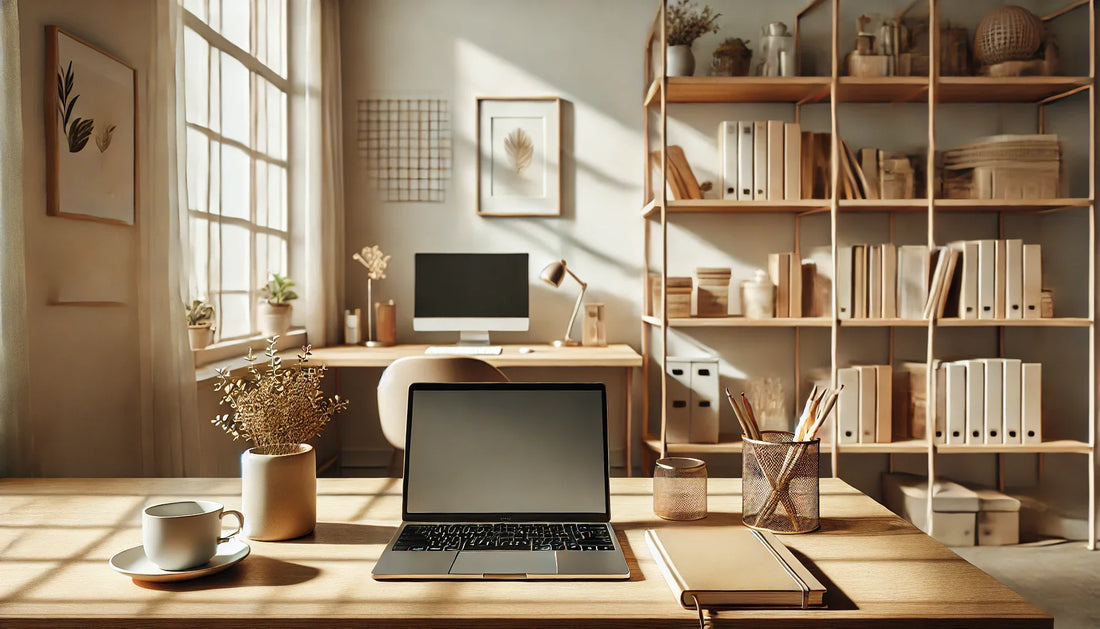
Workspace Clarity — Why Organized Desks Create Quiet Minds
Share
Chaos is not the enemy of progress — confusion is.
And nowhere is confusion more quietly cultivated than upon a desk that has forgotten its purpose.
The modern workspace is an altar of intention. Every pen, every sheet, every cable either serves your focus or sabotages it. Organization, then, is not decoration — it is discipline made visible.
At Prime Office Shop, we believe that a quiet desk is the signature of a clear mind.
1️⃣ The Psychology of Order
Our surroundings mirror our internal architecture.
Cognitive science confirms what intuition already knew — the human brain thrives in structure. Each item within sight demands attention, each pile consumes a fragment of mental energy.
Decluttering a desk, therefore, is not aesthetic indulgence but cognitive preservation.
A clean surface resets perception; it turns space into silence.
Q & A:
Q: Isn’t a little mess creative?
A: Controlled chaos can inspire — but habitual disorder dulls. Creativity blooms from clarity, not confusion.
2️⃣ Tools of Simplicity
Organization does not mean sterility. It means harmony.
Choose instruments that serve without shouting.
-
Minimal trays separate categories — incoming tasks, active work, and archives.
-
Weighted pen holders signal intention and keep essentials within reach.
-
Stackable drawers protect documents while maintaining visual balance.
-
Cable organizers preserve aesthetic flow and reduce sensory noise.
Each piece at Prime Office Shop is chosen not merely for utility, but for proportion — proportion between object and attention.
Q & A:
Q: What is the best first step to decluttering my desk?
A: Remove what doesn’t contribute to your work today. Presence is priority; excess is echo.
3️⃣ The Ritual of Reset
An orderly desk is not a single act — it is a rhythm.
Begin each morning with five minutes of preparation, and each evening with five minutes of return.
This daily choreography builds trust between mind and environment.
Use physical gestures — closing a notebook, aligning a pen, folding a cable — as cues that the workday begins or ends. These micro-rituals define psychological thresholds, preventing burnout and restoring identity beyond the desk.
4️⃣ The Architecture of Focus
Design your workspace as if it were a map of intention:
-
Center Zone: The immediate canvas — monitor, notebook, pen.
-
Perimeter Zone: Storage and references — drawers, files, planners.
-
Peripheral Zone: Inspiration — art, plant, or photo, positioned deliberately.
When each zone aligns with function, the body moves fluidly. Reaching becomes remembering. Focus ceases to be forced; it simply follows the path of design.
5️⃣ Sound, Light & Silence
True organization extends beyond objects.
Light determines rhythm; sound shapes emotion.
Choose warm, indirect lighting for thought, and natural daylight for action.
Mute unnecessary alerts, silence redundant devices.
A clear desk paired with clear sound and light creates what Prime Office Shop calls The Trilateral Harmony — mind, matter, and mood unified through restraint.
6️⃣ The Philosophy of Fewer Things
Fewer things, more meaning.
Minimalism is not subtraction but selection — the quiet confidence of knowing what deserves to remain.
Every object within your workspace should justify its existence:
Does it serve function? Does it inspire purpose? Does it rest without demanding notice?
Q & A:
Q: I struggle to let go of things — how do I begin?
A: Replace guilt with gratitude. Release what served you once so new utility can find its place.
7️⃣ The Quiet Mind
In the end, an organized desk is not about control but compassion.
You are not managing objects — you are protecting attention.
And attention is the most fragile, finite resource of all.
Prime Office Shop’s philosophy is simple: the most beautiful workspace is the one that disappears when you begin to think.
That is not emptiness — that is freedom.
